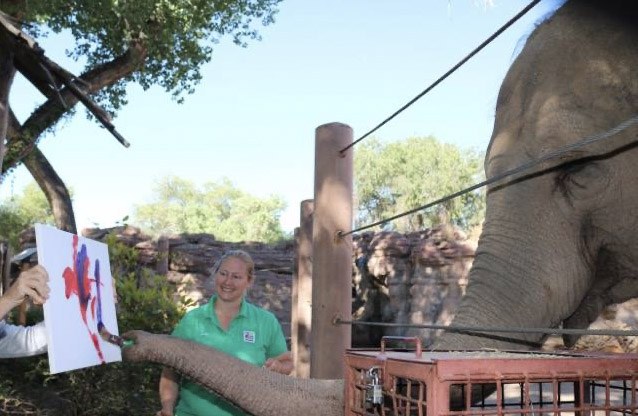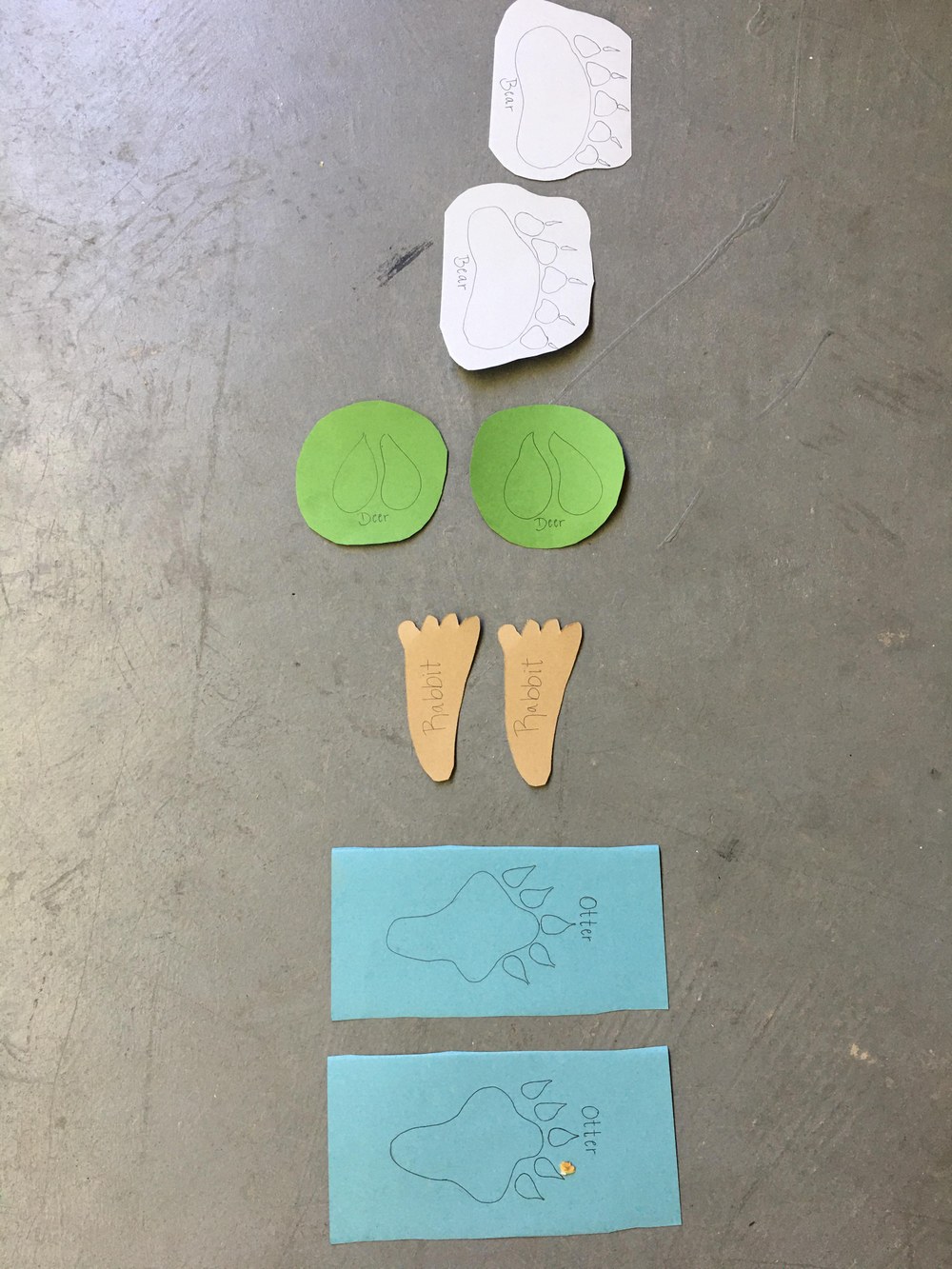Animal Tracks
Learning Goal
Learn about animal track identification, natural history of local wildlife, biodiversity richness and fossil records. Students engage by creating an animal track pathway.
Introduction to Animal/Interest
Wildlife is all around us in natural and even urban areas. Just because we don’t always see it doesn’t mean it isn’t there. There are many signs of wildlife you can look for even if you don't see the animal itself. These signs can include feces or scat, chew or claw marks, den or bedding sites, hair, feathers, and trails commonly traveled by animals.
Animal Tracks
The most noticeable sign of wildlife presence is tracks. Animal tracks are imprints left behind by traveling animals on ground surfaces. You don’t have to be a hunter to benefit from the knowledge gained by observing animal tracks. Identifying tracks can identify the species, individual size, travel patterns and particular movement of an animal. Naturalists (experts who study natural history) can learn a great deal about an animal’s life from the tracks they leave behind. Tracks are also powerful clues that help us predict the number and types of animals in an environment. This information can be helpful when monitoring population size and looking at different ecological interactions (any encounter between animals). This can be particularly interesting because you can learn about animal group behavior and predator/prey relationships.
To find tracks, you need to know where wildlife likes to hang out. Take some time to examine your surrounding environment -- you may find other clues of animals to help further your identification. Much of this is done by what is called “sign tracking.” Signs are anything besides a track that help indicate an animal's activities. About half of tracking is sign tracking and the other half is working with actual tracks. The types of animals you may encounter differ by season, climate and region. Another factor to account for when observing animal tracks is different trail textures such as soil, mud, snow, sand, rock and impervious paved surfaces such as roads, which can make it nearly impossible to find prints.
Once an animal track is discovered, naturalists begin by identifying it. Understanding walking patterns can help you eliminate animal groupings. There are four unique animal grouping track patterns in the animal kingdom: zig-zaggers, waddlers, bounders and hoppers. Zig-zaggers, which include deer, moose, foxes, coyotes and bobcats, move in such a way that their rear paws/hoofs land in the same spot that their front paws/hoofs previously fell. Waddlers like bears, skunks, woodchucks, raccoons, muskrats, beavers and porcupines move from one side of their body to the other. Otters, weasels and other mustelids are bounders. These four-legged creatures place their front feet down and in one motion leap forward by lifting up their front feet and placing their rear feet in the exact same spot where the front feet previously landed. This motion gives the track the appearance of only two feet, side by side. Hoppers “leapfrog” by placing their rear feet slightly ahead of their front feet and pushing off so their front feet land first and their back feet land in front. This pattern is found in rabbits and small rodents.
Identifying the track patterns is only the first step in examining an animal track. Don’t be afraid to get close: squat down next to the tracks so you’re close enough to make out any subtle distinguishable features among the impressions. Examining details such as size of each print and number of toes can lead you to a correct identification. The best way to identify tracks in the field is to carry a regional dichotomous key, which helps you identify specific species by prompting you with either/or choices that direct you to more choices, helping you to identify the species. If you need help identifying your findings, use online resources such as iNaturalist, which collaborates with a community of citizen scientists to confirm observations. In summary, identifying animal tracks promotes observation and awareness of our surroundings, and encourages understanding and appreciation of the natural world.
How the ABQ BioPark Uses Animal Tracking

Enrichment provides opportunities for cognitive and physical environmental stimuli based on natural behavior and instincts of an animal. ABQ BioPark keepers enrich the lives of the animals in their care every day by introducing fun, interesting and complex activities such as painting to the animals’ daily routines.
The artists include penguins, elephants, gorillas, orangutans, alligators, arthropods, snakes, lions, hippos and more. Artwork is created with non-toxic paint using broad brush strokes, paws, noses, bellies, trunks, hooves, fingers or feet. Keepers assist the artists by placing pools of non-toxic paint on a canvas. The animals express their unique artistic stylings using different techniques: scampering, squirming, smearing and even scratching. The New Mexico BioPark Society's animal art gallery features these talented artists. Proceeds from each original painting by zoo residents directly support the ABQ BioPark.
Our Actions Matter
All animals leave a mark on the Earth. Tracks make a lasting impact on recorded history. Fossils are the lithified remains of prehistoric organisms and their associated traces. Paleontologists, the scientists that study fossils, can infer what animals looked and acted like by comparing fossils to traces made by modern day animals. Trace fossils, which are physical evidence of the life activities of extinct species, provide us with indirect evidence of how flora and fauna interacted with their environments. One of the most common and recognizable forms of trace fossils are preserved as footprints. Trace fossils can contain a number of activities such as trails, burrows, nesting sites, animal droppings (known as coprolites), feeding marks and nesting marks. Trace fossils provide behavioral information about the organism that is not revealed by skeletal remains. For example, a trace fossil of a dinosaur nest can give clues about how young were raised. Coprolites could offer evidence about the diets of extinct animals as well. Paleontologists may be able to infer the size and weight of an animal from a single footprint.
How are those impressions preserved over time? Trace fossils form in soft mud or sand near a body of water. The imprints left by organisms are then quickly covered by sediment. The sediment dries and hardens before the imprints are exposed to weathering elements such as wind or water. Over time the sediment becomes buried under more sediment, which compacts it further and it is cemented together to form rock.
Whether the tracks or signs you observe are fossilized or freshly made, it is important to observe and preserve their remains. The preservation of animal tracks and signs can aid in conservation efforts that will lead to a more healthy environment for both humans and wildlife. It is also important for humanity to preserve fossilized tracks to ensure the past richness of biodiversity on Earth is never forgotten.
Activity Description: On the right track

Do you have what it takes to walk a mile in an animal’s footprint?
Materials
- Eight sheets of construction paper of various colors
- Scissors
- Tape
Directions
- Cut two sheets of construction paper in half and use each side to draw a bear paw print.
- Experiment by drawing front and hind feet.
- Repeat the first step by drawing deer, otter and rabbit tracks.
- Experiment with tracing your hand or foot on the paper
- Place a piece of tape and apply it to the bottom of each track.
- Establish your start and finish line.
- Position each set of footprints on the ground at equal distance.
- Further experiment with different distances. What might make an animal take a larger or smaller step?
- Turn sets of footprints in different directions to make the course more challenging.
- Busy trail corridor! Many animals are using this pathway for traveling. Insert multiple animal “footprints” along your path.
- Now hop, skip and jump along to the finish line!
- Mimic different animal movements. Bounce, waddle, hop and zig-zag your way to the finish line.
- What type of direction/movement was most efficient? Most fun?
- Was it difficult for you to move like any of the animals do?
Additional Resources
Use this guide from the Pajarito Environmental Education Center to identify tracks of all shapes and sizes.
With your Albuquerque Public Library card, explore thousands of online resources, ebooks, audiobooks on the go.
